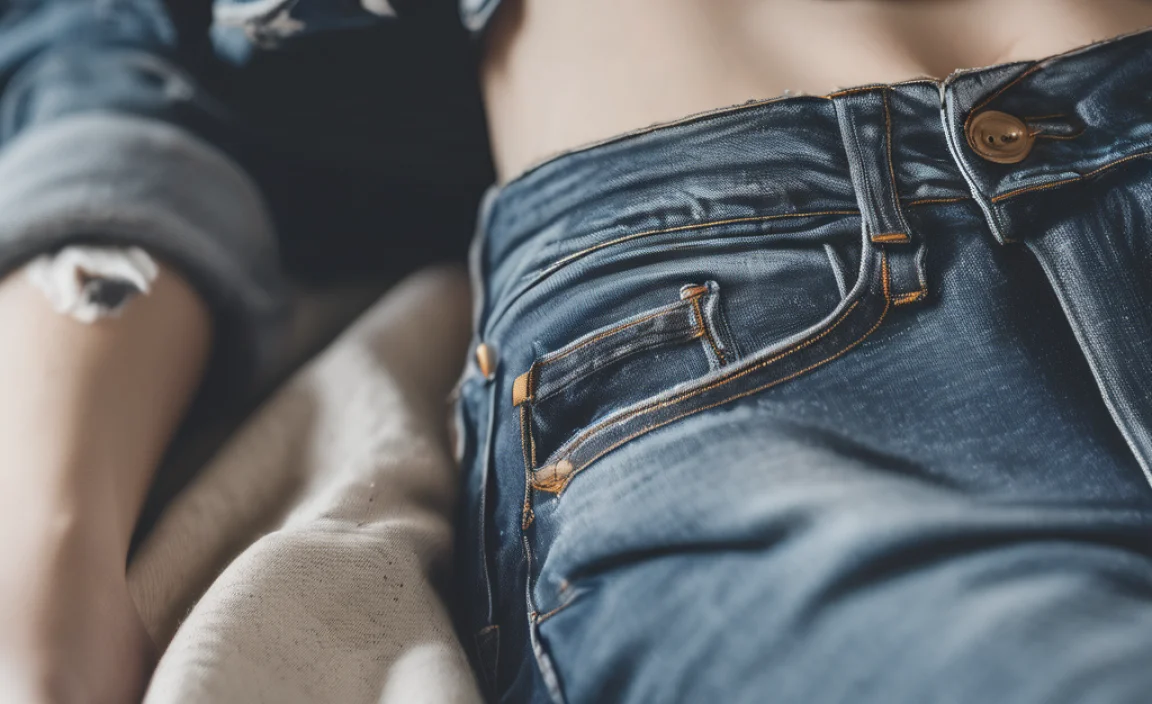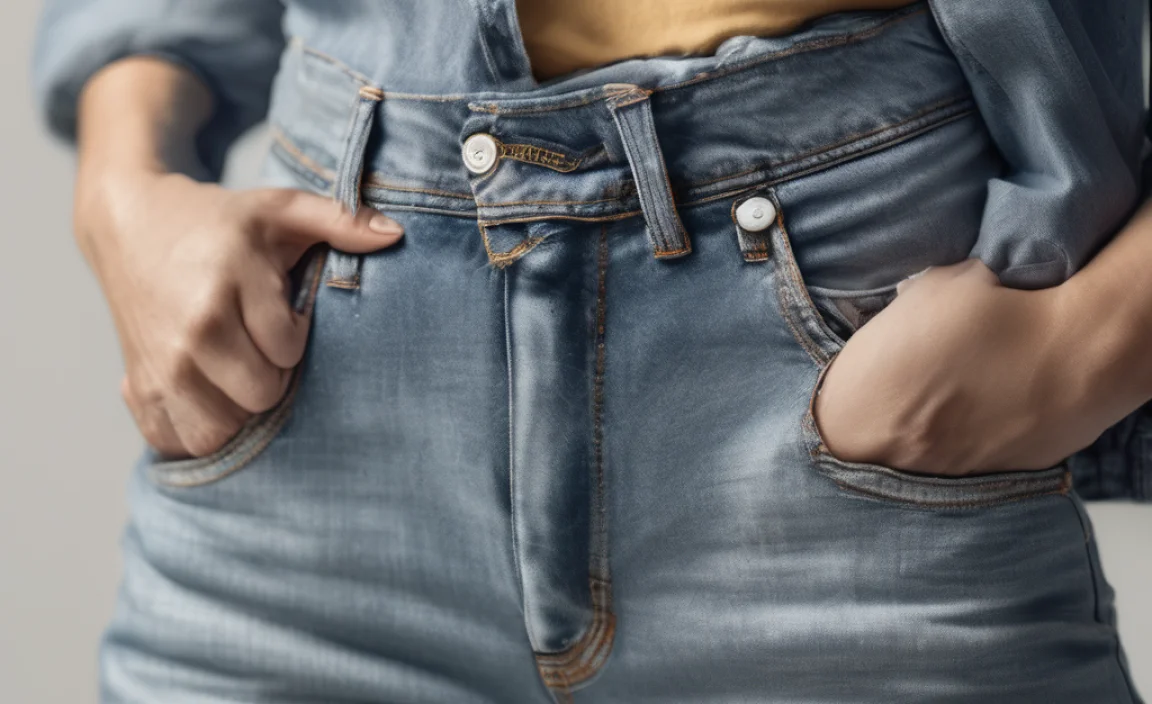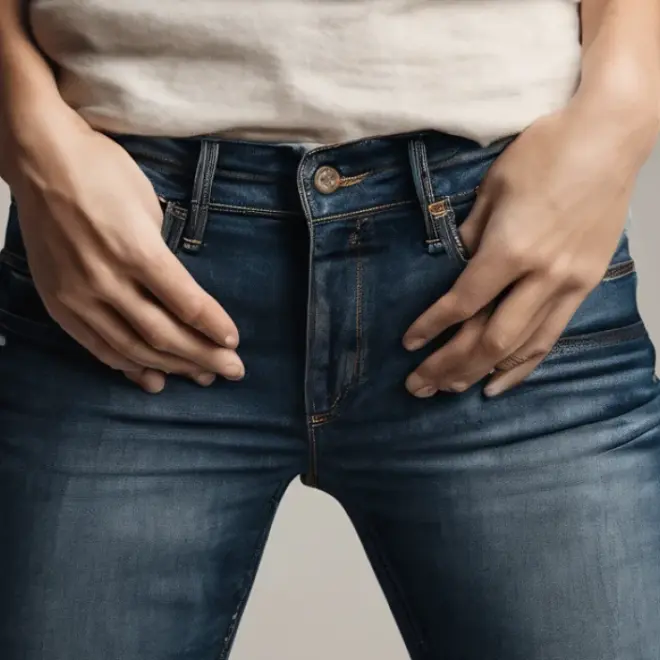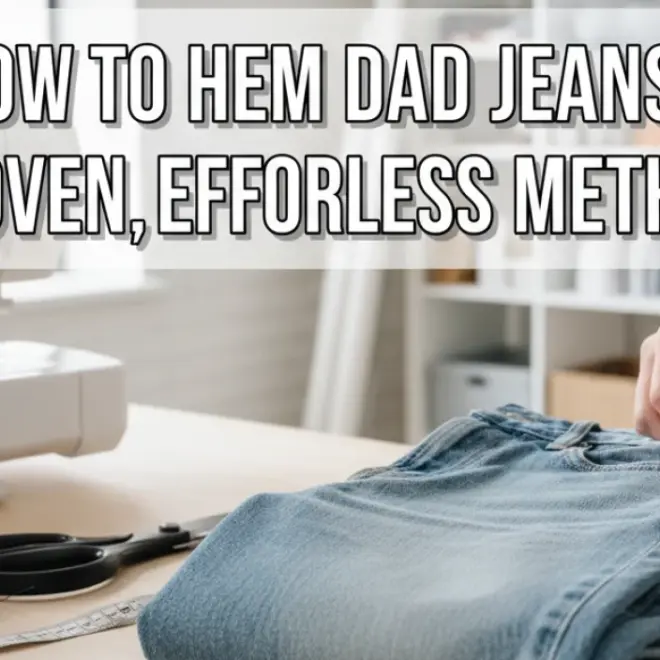Learn how to hem mom jeans easily at home with this beginner’s guide. Get a perfect, custom fit for your favorite high-waisted denim without needing to visit a tailor. It’s quicker and more affordable than you think!
Mom jeans are a classic for a reason – they’re comfortable, stylish, and go with almost anything. But if yours are a little too long, they can look sloppy instead of chic. Don’t let a minor length issue sideline your favorite pair! Many beginner sewers feel intimidated by altering clothes, but hemming mom jeans is a straightforward project. With a few basic tools and clear instructions, you can achieve a professional-looking finish that perfectly suits your height and style. Get ready to transform your denim with this simple, step-by-step guide.
Why Hemming Your Mom Jeans is a Game-Changer

Wearing jeans that are the right length makes a huge difference in how they look and feel. Jeans that are too long can bunch up around your ankles, shortening your legs and making your overall silhouette appear less polished. On the other hand, jeans that are too short can look awkward and unintentional. Getting the hem just right ensures your mom jeans look intentional, stylish, and flattering, no matter how you wear them.
For many, the thought of altering clothing conjures images of complicated sewing machines and intricate techniques. The good news is, hemming is one of the most accessible sewing projects for beginners. It requires minimal materials and can be done by hand or with a basic sewing machine. Mastering this skill not only saves you money on tailor fees but also gives you the confidence to customize your entire wardrobe.
Gathering Your Supplies: The Essential Toolkit

Before you start, let’s make sure you have everything you need. Having all your supplies ready will make the process smooth and efficient. You don’t need a fancy sewing kit; most of these items are likely already in your home or can be found affordably at a craft or fabric store.
What You’ll Need:
- Your Mom Jeans: The star of the show! Make sure they are clean and dry.
- Fabric Scissors: Sharp scissors are crucial for a clean cut. Regular household scissors can make fabric fray unevenly.
- Measuring Tape or Ruler: For accurate measurements. A flexible fabric measuring tape is ideal.
- Fabric Chalk or a Disappearing Ink Pen: To mark your cutting and sewing lines.
- Pins: Straight pins to hold the fabric in place as you work.
- Thread: Choose a color that matches your jeans as closely as possible. If you can’t find an exact match, a slightly darker neutral like grey or dark blue often works well.
- Needle: A standard sewing needle for hand-sewing, or a sewing machine with a universal needle (size 80/12 or 90/14 is usually good for denim).
- Sewing Machine (Optional but Recommended): For a quicker and more professional-looking finish. If you don’t have one, hand-sewing is perfectly fine.
- Iron and Ironing Board: To press seams and ensure crisp lines.
Step-by-Step Guide: How to Hem Mom Jeans

This guide focuses on creating a classic, clean hem. We’ll walk through each step to ensure you get a professional look without any fuss. Remember, practice makes perfect, and your first attempt will still be a huge win!
Step 1: Try Them On and Determine the Desired Length
This is the most critical step for a perfect fit. Wear the shoes you’ll most commonly wear with your mom jeans. Stand in front of a mirror and note where you want the hem to fall. Mom jeans often look best hitting at or slightly above the ankle bone. Pin the jeans at the desired length as you try them on. Make sure to check both sides and the front and back to ensure an even hemline.
Pro Tip: If you want a slightly rolled or cuffed look, make sure you account for that extra length when deciding where to cut. It’s always better to cut less than you think you need; you can always trim more!
Step 2: Mark Your Cutting Line
Once you’re happy with the pinned length, lay your jeans flat on a table or the floor. Smooth out any wrinkles. Using your fabric chalk or disappearing ink pen, mark a clear line along the folded edge of the denim at your desired hem length. If you’re measuring from an existing hem you’re removing, measure from that point to your desired length. Be precise!
How to Measure Precisely:
- Measure from the inseam (the seam on the inside of the leg) upwards to your desired length.
- Transfer this measurement to the outseam (the seam on the outside of the leg).
- Use a ruler to ensure these measurements are consistent all the way around the circumference of the leg opening.
This ensures your hem will be straight and even once sewn. It’s also a good idea to add a seam allowance for folding. A typical seam allowance for hemming denim is about 1 to 1.5 inches (2.5 to 4 cm). This extra fabric will be folded up twice to create a sturdy, clean hem. Mark this additional allowance below your initial cut line.
Step 3: Cut Off the Excess Fabric
Using your sharp fabric scissors, carefully cut along the marked cutting line. Take your time and try to cut as straight as possible. If your mom jeans have a finished hem you’re removing, you can cut just above that original hem first, then measure and cut to your final desired length. This gives you more control.
Important Note: Once you cut, you can’t add fabric back! Double-check your marks before you cut. If you’re unsure, err on the side of leaving the fabric longer. You can always shorten them further.
Step 4: Prepare the New Hem
Now, you need to fold and press the new hem. Take the raw edge of the fabric (where you just cut) and fold it upwards by about 0.5 to 0.75 inches (1.25 to 2 cm). Use your iron to press this fold firmly. This creates a small, neat edge.
Next, fold this already-folded edge up again by the remaining amount of your seam allowance (usually 0.5 to 0.75 inches or 1.25 to 2 cm). This second fold encloses the raw edge, preventing fraying and giving you a clean finish. Press this double fold with your iron. Pin the hem in place all the way around the leg opening, ensuring the pins go through all layers of the fabric and lie flat.
Step 5: Sew the Hem
This is where your chosen sewing method comes into play.
Option A: Sewing by Hand
Thread your needle with a sturdy thread color that matches your jeans. Tie a knot at the end of the thread. Start sewing from an inconspicuous spot, like along the inseam. Use a hem stitch (also known as a blind stitch or slip stitch). This stitch is designed to be almost invisible from the outside. Only pick up a thread or two from the folded hem and the main fabric with each stitch. Continue around the entire leg opening, keeping your stitches small and even. When you reach the beginning, tie off your thread securely with a knot.
Basic Hem Stitch (Slip Stitch) Steps:
- Bring your needle up from the fold of the hem.
- Take a tiny stitch (about 1/8 inch or 3mm) on the main fabric of the jeans, picking up just a few threads.
- Slide your needle through the folded hem for about 1/2 inch (1 cm) before bringing it out to make your next stitch on the main fabric.
- Repeat, keeping stitches even and close together.
- Secure with a knot when finished.
Option B: Sewing with a Machine
Set up your sewing machine with a universal needle and a thread matching your jeans. Place the pinned hem under the presser foot, aligning the edge of the folded hem with the seam allowance you pressed earlier (e.g., 0.5 to 0.75 inches or 1.25 to 2 cm from the raw edge). Start sewing with a straight stitch, backstitching at the beginning and end to secure the seam. Sew slowly and steadily around the leg opening. For a more authentic look, you can use a denim needle and a stitch length of about 2.5-3 mm. Once you’ve sewn all the way around, backstitch again and trim any excess threads.
Machine Sewing Tip: To get a strong, durable seam, you can sew a double line of stitches. The first line can be just inside the inner fold, and the second line can be placed where the original hem stitching was, on the outside of the jean leg. This mimics the look of a manufactured jean hem.
Step 6: Finishing Touches
After sewing, remove all the pins. Give your newly hemmed jeans a good press with your iron. This helps set the stitches and ensures the hem looks crisp and clean. Turn your jeans right-side out and admire your handiwork!
Choosing Your Hem Style: Beyond the Basic

While a traditional clean hem is fantastic, mom jeans lend themselves well to a few different stylistic approaches:
1. The Clean Hem (Covered Above)
Pros: Classic, versatile, works for any occasion, maintains the original jean look but with a perfect length.
Cons: Requires sewing to prevent fraying, might look too “finished” if you prefer a more casual vibe.
2. The Cuffed or Rolled Hem
This is a popular choice for mom jeans as it adds a casual, stylish flair and allows for adjustable length. You’ll hem them a bit longer than your desired final length, fold them up twice (usually 1-1.5 inches each fold), and then sew the hem at the top fold. The raw edge is still visible on the outside of the cuff.
How to Achieve:
- Mark your desired final hem length (e.g., where you want the cuff to sit after folding).
- Add your seam allowance for a double fold (e.g., 2-3 inches or 5-8 cm). Cut.
- Fold up the raw edge about 1-1.5 inches and press.
- Fold up again by another 1-1.5 inches (so the raw edge is exposed on the outside) and press.
- Pin and sew this top fold in place using your sewing machine with a straight stitch, or by hand with a hemming stitch, keeping the stitches visible on the outside for a casual look.
Pros: Very stylish, adjustable length, easy to create a distressed look.
Cons: Adds bulk, visible stitching can be less formal.
3. The Raw Hem (Distressed Look)
This look is very on-trend for mom jeans. You simply cut the jeans to your desired length and then fray the edge. No sewing is required, but you’ll need to take steps to prevent excessive fraying.
How to Achieve:
- Mark and cut your jeans to your desired length, leaving no extra seam allowance.
- To encourage fraying, run your jeans through the wash and dry cycle once or twice.
- You can also gently pull threads from the cut edge to encourage fraying.
- To stabilize the fraying to a certain extent and prevent it from unraveling too much, you can sew a single line of stitching just above the cut edge (about 1/8 to 1/4 inch up).
Pros: Trendy, effortless look, no sewing required beyond stabilization.
Cons: Can fray too much over time if not stabilized, not suitable for formal occasions. For more on stabilizing fabric and preventing premature wear, resources like those from The Textile School offer insights into fabric durability.
Troubleshooting Common Hemming Issues

Even the most experienced sewers run into minor hiccups. Here are a few common issues and how to fix them:
My hem looks wavy or puckered.
Cause: The fabric wasn’t pressed well, stitches were too tight, or the needle/thread combination isn’t ideal for denim.
Fix: If it’s minor, try pressing firmly with your iron. For more significant puckering, you might need to carefully remove the stitching and re-do it, ensuring the fabric is smooth and the tension on your sewing machine is correctly set. A walking foot on your sewing machine can also help feed layers of fabric evenly.
The stitching is uneven.
Cause: Sewing too quickly, inconsistent pinning, or machine tension issues.
Fix: For hand-sewing, focus on consistent stitch length and tension. For machine sewing, practice on scrap fabric and adjust tension settings. If it’s only slightly uneven, pressing well might disguise it. Otherwise, unpick and resew.
I cut too much fabric off.
Cause: Measurement error, fabric shifting, or misjudgment.
Fix: This is the trickiest one! If you cut short, you can add a band of contrasting fabric (like lace or a different wash of denim) to the bottom, or resort to a cuffed hem where the extra length is folded up. For extreme cases, you might need a new pair of jeans. Always measure twice, cut once!
My jeans look different lengths after hemming.
Cause: Uneven marking, pins shifting, or the leg shape creating optical illusions.
Fix: Lay the jeans flat, compare the hems directly, and use your measuring tape to find the discrepancy. You can either adjust the longer side by carefully unpicking and re-hemming, or embrace the slight difference if it’s minimal and not noticeable when worn. Wearing them with shoes often helps reveal true length.
Frequently Asked Questions About Hemming Mom Jeans
Q1: Can I really hem jeans without a sewing machine?
A: Absolutely! A simple hem stitch or a slip stitch done by hand can create a durable and neat finish. It takes more time, but the results can be just as professional.
Q2: What’s the best way to hem mom jeans to look like the original?
A: To mimic the original hem, you can try to preserve the original factory hem. Cut below the original hem, fold your new hem allowance up, then fold it up again to the original hemline. Sew just above the original hem’s stitching line on the outside of the jean. Alternatively, sew a new hem on the inside as described in the clean hem method, using matching thread.
Q3: How much fabric should I leave for the hem allowance?
A: For a clean, doubled-over hem on denim, plan for about 1 to 1.5 inches (2.5 to 4 cm) of fabric for your hem allowance. This allows for a neat fold and a sturdy finish.
Q4: What kind of needle and thread should I use for denim?
A: For machine sewing, a “denim” or “jeans” needle (typically size 14 or 16) is best. For hand-sewing, a sturdy “sharps” needle works well. Use a strong polyester thread for durability, ideally matching the color of your jeans.
Q5: Will cutting my jeans for a raw hem cause them to unravel completely?
A: They will fray, but they won’t usually unravel completely if done correctly. A wash or two will start the fraying. For stability, sewing a line of stitches about 1/8 to 1/4 inch above the cut edge is recommended to prevent excessive unraveling.
Q6: How do I ensure the hem is the same length on both legs?
A: The best way is to try the jeans on with your preferred shoes and mark the length. Then, lay the jeans flat and measure the inseam and outseam length from the crotch down to your mark on each leg, ensuring they match. A tailor’s trick is to fold the jeans in half lengthwise and compare the leg openings directly.
Conclusion: Confidence in Every Stitch
Hemming your mom jeans might seem like a small alteration, but it makes a significant impact on how polished and confident you feel in your favorite pair of denim. You’ve learned precisely how to measure, cut, fold, and sew a perfect hem, whether you prefer a clean, classic look, a trendy cuffed style, or a casual raw edge. Remember that the goal is to make your clothes fit you perfectly, and this skill empowers you to do just that.
Don’t be discouraged if your first attempt isn’t absolutely perfect. Every sewing project is a learning opportunity. With practice, you’ll become faster and more precise











